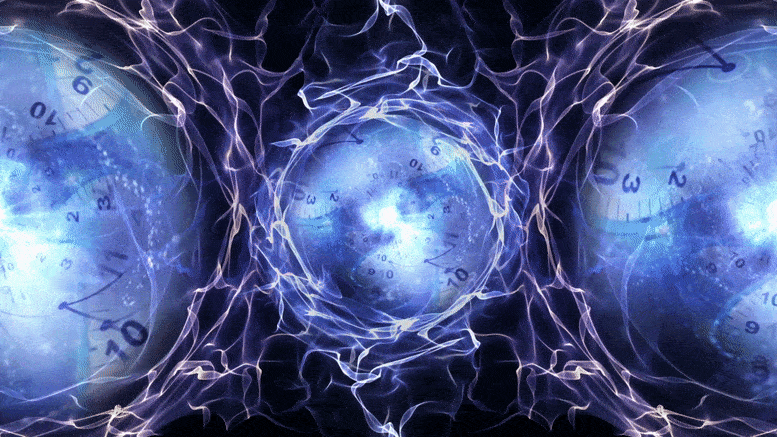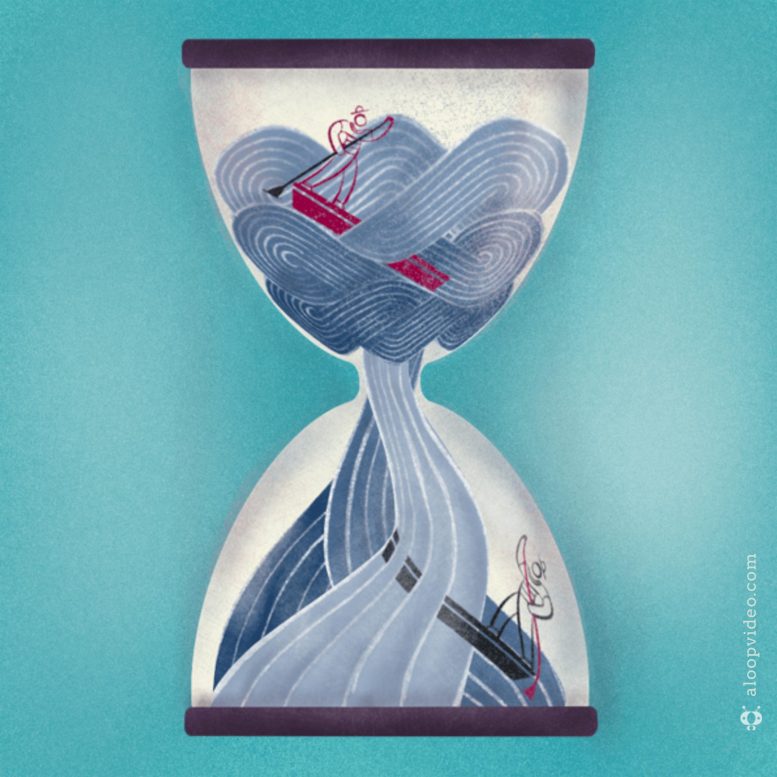
New study shows the boundary between time moving forward and backward may blur in quantum mechanics.
A team of physicists at the Universities of Bristol, Vienna, the Balearic Islands and the Institute for Quantum Optics and Quantum Information (IQOQI-Vienna) has shown how quantum systems can simultaneously evolve along two opposite time arrows — both forward and backward in time.
The study, published in the latest issue of Communications Physics, necessitates a rethink of how the flow of time is understood and represented in contexts where quantum laws play a crucial role.
For centuries, philosophers and physicists have been pondering the existence of time. Yet, in the classical world, our experience seems to extinguish any doubt that time exists and goes on. Indeed, in nature, processes tend to evolve spontaneously from states with less disorder to states with more disorder, and this propensity can be used to identify an arrow of time. In physics, this is described in terms of ‘entropy’, which is the physical quantity defining the amount of disorder in a system.

© Aloop Visual & Science, University of Vienna, Institute for Quantum Optics and Quantum Information of the Austrian Academy of Sciences
Dr. Giulia Rubino from the University of Bristol’s Quantum Engineering Technology Labs (QET Labs) and lead author of the publication, said:
“If a phenomenon produces a large amount of entropy, observing its time-reversal is so improbable as to become essentially impossible. However, when the entropy produced is small enough, there is a non-negligible probability of seeing the time-reversal of a phenomenon occur naturally.
“We can take the sequence of things we do in our morning routine as an example. If we were shown our toothpaste moving from the toothbrush back into its tube, we would be in no doubt it was a rewinded recording of our day. However, if we squeezed the tube gently so only a small part of the toothpaste came out, it would not be so unlikely to observe it re-entering the tube, sucked in by the tube’s decompression.”
The authors of the study, under the lead of Professor Caslav Brukner of the University of Vienna and the IQOQI-Vienna, applied this idea to the quantum realm, one of whose peculiarities is the principle of quantum superposition, according to which if two states of a quantum system are both possible, then that system can also be in both states at the same time.
“Extending this principle to time’s arrows, it results that quantum systems evolving in one or the other temporal direction (the toothpaste coming out of or going back into the tube), can also find themselves evolving simultaneously along both temporal directions.
“Although this idea seems rather nonsensical when applied to our day-to-day experience, at its most fundamental level, the laws of the universe are based on quantum-mechanical principles. This begs the question of why we never encounter these superpositions of time flows in nature,” said Dr. Rubino.
Dr. Gonzalo Manzano, co-author from the University of the Balearic Islands, said: “In our work, we quantified the entropy produced by a system evolving in quantum superposition of processes with opposite time arrows. We found this most often results in projecting the system onto a well-defined time’s direction, corresponding to the most likely process of the two. And yet, when small amounts of entropy are involved (for instance, when there is so little toothpaste spilled that one could see it being reabsorbed into the tube), then one can physically observe the consequences of the system having evolved along the forward and backward temporal directions at the same time.”
Aside from the fundamental feature that time itself might not be well-defined, the work also has practical implications in quantum thermodynamics. Placing a quantum system in a superposition of alternative time’s arrows could offer advantages in the performance of thermal machines and refrigerators.
Dr. Rubino said: “Although time is often treated as a continuously increasing parameter, our study shows the laws governing its flow in quantum mechanical contexts are much more complex. This may suggest that we need to rethink the way we represent this quantity in all those contexts where quantum laws play a crucial role.”
Reference: “Quantum superposition of thermodynamic evolutions with opposing time’s arrows” by Giulia Rubino, Gonzalo Manzano and Časlav Brukner, 26 November 2021, Communications Physics.
DOI: 10.1038/s42005-021-00759-1
This research was funded by the Royal Society, the European Union’s Horizon 2020 research and innovation program, the Austrian Science Fund (FWF), the European Commission, the Foundational Questions Institute (FQXi) and the John Templeton Foundation.
The University’s Research Institutes involved in this research are the Quantum Engineering Technology Labs (QETLabs) at the University of Bristol, the Institute for Cross-Disciplinary Physics and Complex Systems (IFISC) UIB-CSIC, at the Universitat Illes Balears, the University of Vienna and the Institute for Quantum Optics and Quantum Information in Vienna.
Never miss a breakthrough: Join the SciTechDaily newsletter.
5 Comments
If time is mutable on a quantum level, then wouldn’t it be possible that when we see “spooky action from a distance,” it’s actually a time distortion where, when one particle is flipped, the other reverts back in time to when it had been paired, flips it’s charge accordingly, then returns to it’s normal place in space-time. Just a thought, but if quantum particles don’t have to obey the forward motion of time, then jumping back to an original position to correct a quantum pairing shouldn’t be too hard to consider as a reasonable reality to what’s actually happening.
I mean, Einstein probably wouldn’t have assumed that particles could jump back in time so they could keep a relationship it has with another particle in balance. But if quantum information isn’t bound to the same stringent rules of time as we are, the simplest answer is usually the right one, and particle time travel seems to be the simplest answer to this situation.
Or is the paired particle flip action (energy), being used to revert the time position of the paired particles to the pairing moment so the “flip” state only need to occure in a very localised environmemt? Either state action “flip” could be tested with a measurment of the energy needed to “flip” at different time stages.
Mathematics has a real part & an imaginary part that makes up a number that exists partially in the real world & partially in the imaginary world. Let’s say that anything solid in our real world is equivalent to rolled space which is solid. Rolled space with a mass of (32) occupies one Murkowski (x, y, z) space at clock time (t).The rolled space partially exists in the quantum world at the same time similar to a photon. In the quantum world based on time rather than space I=it has (2) spins, each (10.66666667), going in both directions. It has (2) wobbles, each (1.666666667), going in two directions. The quantum world exists in units of time rather than space hence calculations can be done here in terms of time compared to calculations done in our world in terms of space.
David entanglement is highly misunderstood. Waves vintage up and down. QE is whe. Two waves (the particles) resonate together. As such as long as they remain coherent when one is up the other is down. This does not involve any form of magic it simple involves the particles wave function to do what it naturally does without interference to large as that damages entanglement. This action as a distance is not spooky… Its just vibrating as it was. PS spooky action at a distance wave about nonlocality not entanglement lime everyone seems to believe
… even time emerges from the quantum time, it is bit like those Aztec puzzles that give a rise to order from disorder…and some of that water tap… I don’t use Viber, though…